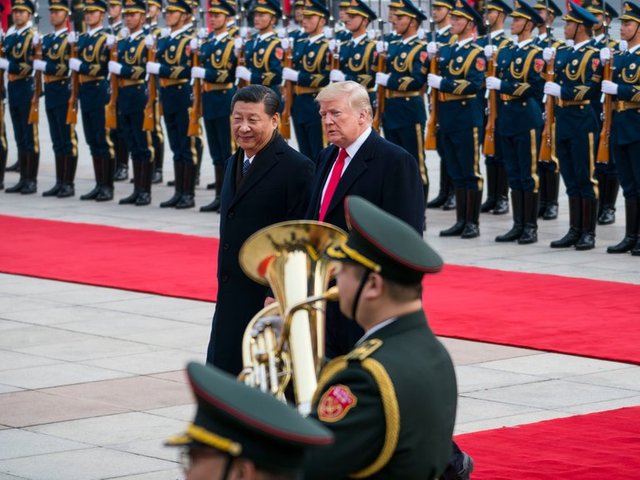President Trump is incidental to China’s ambitions, a mere blip on a 33-year plan. In a speech last month, President Xi Jinping set out the objectives with great clarity. By 2035 China will be a “global leader in innovation,” showing “solid progress” toward “prosperity for everyone.” By 2050, China will be a “global leader in terms of composite national strength” and a “great, modern socialist country.”
Xi gave Trump a warm welcome this week, said the Pacific was big enough for both nations and offered business agreements. Trump made nice and suggested that China and the United States could solve “almost all” of the world’s problems, “and probably all of them.” This was the noise. The real story is growing Chinese strength, steady Chinese purpose aimed at midcentury dominance and erratic American outbursts suggestive of a petulant great power’s retreat.
China is busy. It has the reserves, the surpluses and the growth to shape the world. More important, it has the pride and the confidence to think long term. America First, Trump’s ugly slogan, reeks of retrenchment. By contrast, Xi’s One Belt, One Road initiative is an enormous infrastructure project designed to use Chinese money and technology to reconnect the old Silk Road and tie nations to China. In scope and value it dwarfs the Marshall Plan, the postwar reconstruction program for Europe that was a farsighted expression of American confidence almost 70 years ago.
Xi’s speech to the 19th National Congress of the Communist Party of China marked his apotheosis. He has joined the pantheon along with Mao Zedong and Deng Xiaoping. His thought is now dogma. His China has entered a different phase. Having grown independent and then rich, it is now “becoming strong.”
To what end will the strength be used? China, Xi said, “offers a new option for other countries and nations who want to speed up their development while preserving their independence.” A new era has begun “that sees China moving closer to center stage.”
There could scarcely be a more explicit offer of China as an alternative, single-party, authoritarian model to the liberal democratic system of the United States (of which Trump has been such a feeble advocate). China is now “actively pursuing almost an ideological competition with the United States,” said Yun Sun, a senior associate at the Stimson Center. Xi’s speech was “a declaration of the Chinese saying that we have won this game, we are winning this game.”
They are, for now. The Chinese gambit — in the past, China has been reticent about offering itself as a global paradigm — comes at a moment of American democratic fracture. It’s a good moment for Beijing to talk of arriving “center stage.” Trump does not really have ideas. He has impulses (like his dangerous infatuation with Saudi Arabia).
On his Asian swing, the president spoke of pursuing a “free and open Indo-Pacific region” built around democracies including India, Japan and Australia. This was the right thing to say to counter China. Hundreds of millions of Asians outside China don’t want to find themselves obliged to study Xi Jinping Thought. They prefer liberalism to Leninism.
Xi Jinping Thought calls for building the Chinese military into “world-class forces that obey the party’s command, can fight and win.” It portrays the leadership of the Communist Party as “the defining feature” of Chinese society.
So Trump’s commitment to Indo-Pacific freedom is significant. It’s also dubious. Trump likes surpluses, hates deficits. It’s not clear whether any Trump strategy can get beyond such zero-sum rabble-rousing.
Around Asia, the last thing countries want is to have to choose between China and the United States. From Singapore to Myanmar, they know that America is the only possible balance to China. If China is money and investment, the United States is security and freedom. The Chinese-American relationship is what the regional order depends on.
Those Chinese targets for 2035 and 2050 presuppose one essential thing: regional stability. That’s the headline, not Trump’s machinations. A second Korean War would be a nuclear war. This is the last thing China wants.
The second-to-last thing is the end of the North Korean regime and a united Korean Peninsula at its border, allied to the United States. China’s rise to dominance is predicated on stability until that dominance is achieved. Kim Jong-un, the North Korean leader, must be managed in this context.
Therefore, China will try to squeeze Kim, not to the point of denuclearization (let alone collapse) but to the point where he does not further provoke the United States or Japan. The question is whether Kim is controllable.
The other question is whether Trump is controllable. Xi projects the image of a reliable partner committed to an open, stable trading system. Trump, meanwhile, goes on walkabout with the Saudis.
For now, a conventional Saudi-backed war in Lebanon against Iranian-backed Hezbollah is more likely than nuclear war with Pyongyang. These things happen when an America-First American president can’t think beyond next week (or money).

Hi! I am a robot. I just upvoted you! I found similar content that readers might be interested in:
https://www.nytimes.com/2017/11/10/opinion/china-trump.html
Downvoting a post can decrease pending rewards and make it less visible. Common reasons:
Submit